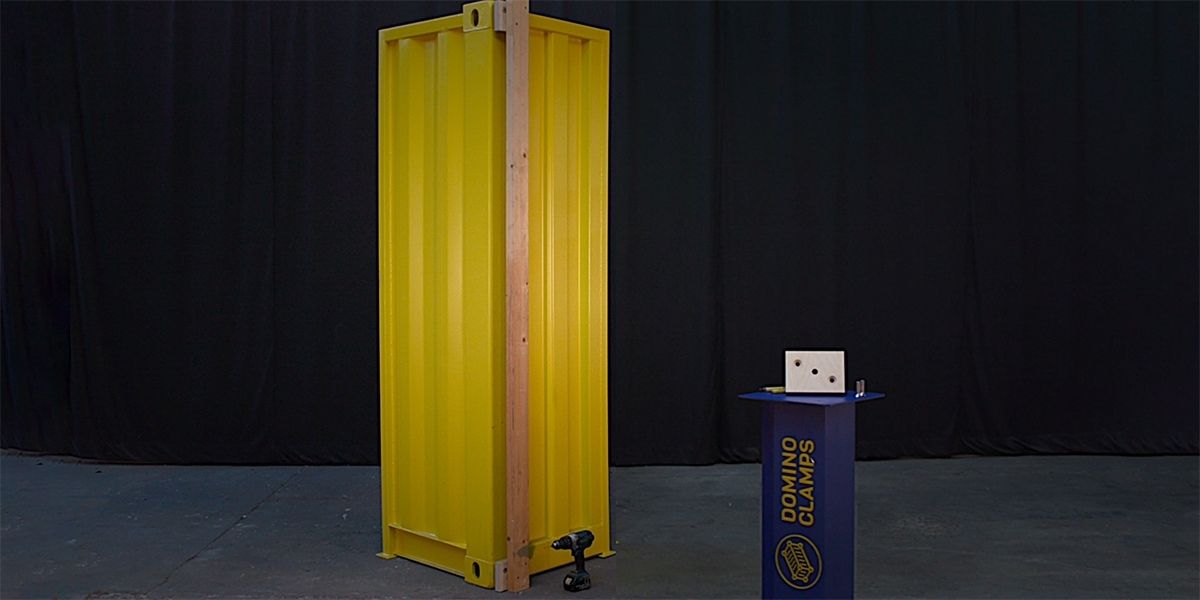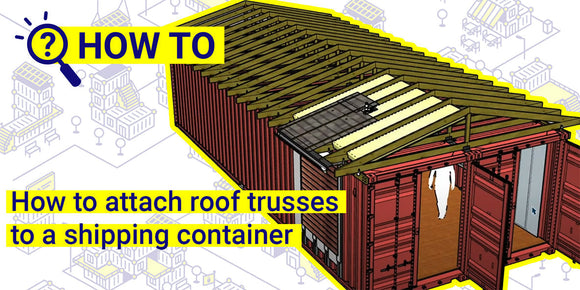
How to Fix Timber to a Shipping Container
6 comments
Timber is relatively cheap, readily available and easy to work with, so it's the ideal starting point for lots of structural extras and accessories to your shipping container project.
We will show you how to fix timber to a shipping container without drilling or screwing into the container.
You will be able to attach lightweight timberwork like shipping container cladding, shuttering ply, stage flats, or quickly attach things like wooden signposts.
For more heavy duty applications such as building a structure off the side, or on top of your container read our post on how to bolt structural timber to a shipping container.

Why would I need to fix timber to a shipping container?
One of the most common reasons for attaching timber to shipping containers is to add some cladding or siding.
Shipping container cladding can be used to provide insulation or to enhance the appearance of the container, helping it blend in to its surroundings. Insulation such as spray foam applied to the inside of a shipping container can take up valuable room which is why some people choose to add the insulation to the exterior of the container and then cover it in a weatherproof cladding.
Read our Step-by-Step Guide:
How to Clad a Shipping Container
Most tutorials will tell you to start by fixing timber battens to the walls of your container, because then it's easy to screw sheet material directly to the side of the container. They will suggest using glue or screwing through the sides of the container.
Both of these are obviously not ideal, and no good at all if it’s not your container!

Attach without screwing or drilling into the container
Many people are far more comfortable using woodworking tools than metalworking ones, so being able to fix timber and sheet materials to a shipping container was always a high priority for us.
With our new timber Bolt On adapter, made from 30mm birch plywood, you can easily cover your shipping container in cladding, shuttering ply, or stage flats, or quickly attach things like wooden signposts.
What you'll need for each fixing point
For each Timber fixing point at the corner of a shipping container, you’ll need:
- A Domino Clamp*
- A Plywood Bolt On adapter for timber,* with two M12 x 45mm Countersunk screws*
- A 10mm and an 8mm hex key
- Your timber
- Your woodworking tools
- Correct length woodscrews (see step 3)
* These can also be purchased together as a kit.

Instructions
- Use your 6mm hex key to attach one plywood Bolt On adapter to your Domino Clamp using the M12 countersunk screws which come with the adapter.
- Attach one Domino Clamp in the top corner casting of the shipping container and one in the bottom, if you're unfamiliar with the technique, follow our detailed installation instructions.
-
Check you have the correct length wood screws, by adding together the thickness of the adapter (30mm) to the thickness of what you need to screw to it, and making sure your screws are at least 5mm shorter than that.
For instance, if you are attaching a 50mm x 50mm batten to the adapter; 50+ 30 = 80mm is the total thickness before the screw would hit the domino clamp. So stick to 70mm screws.
With the plywood adapter now firmly fixed to the container, you can now screw your timber or sheet material to the two unused areas on the plywood Bolt on, using the correct length screw, and drilling a pilot hole if necessary.
NOTE: if you prefer step 1 and step 2 can be done in the opposite order, since the central hole in the adapter will allow you to attach and detach the Domino Clamp from the shipping container corner casting even when the Plywood is fixed to it.
How to add extra support for long horizontal timbers
Along the long length of the container, you may want to support the horizontal timbers at the midway point, to prevent them from sagging. Our shipping container roof bracket attaches to the container's top side rail to do exactly this. This is especially useful when working on a 40’ container or when attaching heavier structures.
One or more of these roof brackets along each side of the container will keep long timbers held secure to the top side rail of the container. Just make sure to select the appropriate length bolt from the dropdown menu when ordering the roof bracket, based on the size of the timber you are using.
Shipping Container Brackets
We also have a range of shipping container brackets suitable for attaching timber to your shipping container.
The brackets will help you attach things to a container beyond what Domino Clamps and plywood adapters can do by changing the size and position of the attachment point, as well as moving the attachment plane from vertical to horizontal.
Find out how to frame your shipping container here or you can download our detailed guide for attaching a timber frame.






Comments (6)
Can you advise me on how many clamps needed to connect two 6m wide roof to two 20ft containers?
Shipping will be to NSW, Australia.
Also price & bank info.
Hi,
We have a shipping container. I am thinking about cladding the exterior. How much is the complete kit that is required to execute this ambition?
Regards, Steve.
Hi – Very interested in buying the clamp and adapter for a 20 ft container in Melbourne, Australia.
Can you let me know shipping and approximately how many clamps & plywood adapters would need?
Thanks, Chris
Hi would you advise where I can get the domino clamps and cladding adapters in New Zealand?
If not available anywhere here a price to purchase and shipping please. Also if no distributor here I would be interested in being one.
Maybe cover all bases, a new distributor, even if there currently is one.
Regards
Robyn Mitchell
Could you please send all info re pricing and shipping to Australia
Wonderful that people think out of the box !!!
Very interested in your product.
Now live in Australia originally UK.
Look forward re your pricing and all info.
Kind Regards Anne.